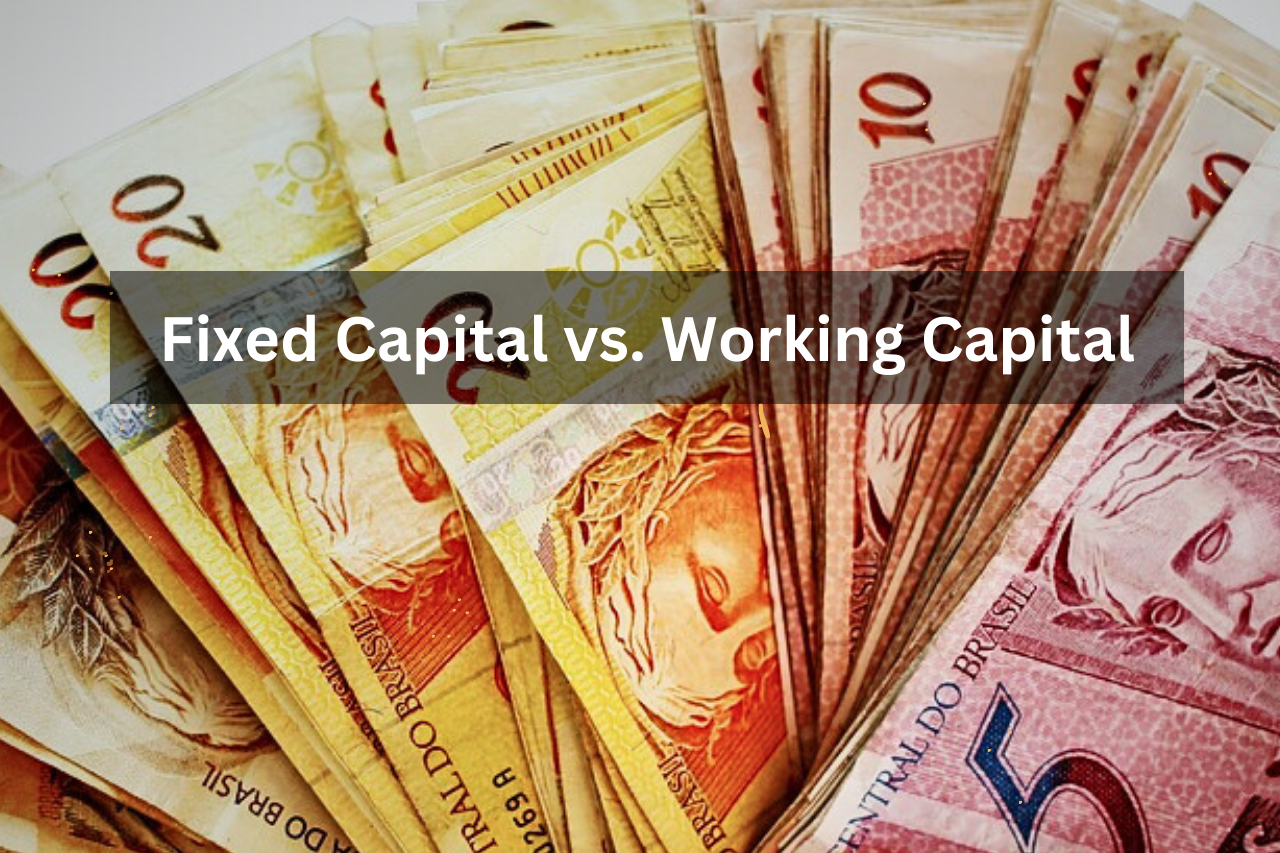Difference Between Fixed Capital and Working Capital | Notes with Examples, Factors, Tips – 2024
Below is the difference between fixed capital and working capital
This is the learning version about the main difference between fixed capital and working capital.
We have discussed about:
- Fixed Capital vs Working Capital
- Key Funding Sources
- Strategies for Effective Cash Flow Management
- Importance of Balancing Long term and Short term Needs
- Cash Flow for Financial Stability
- Adapting to Market Changes for Sustainable Growth
Fixed Capital vs Working Capital
Fixed Capital
- Fixed capital includes durable (long lasting) assets which are basically required to operate a business.
- Fixed capital lacks liquidity and cannot be easily exchangeable for cash.
Examples of fixed capital:
Assets such as land, building, other structures, vehicles, machinery, and equipment.
Working Capital
- Working capital consists of resources for daily (short term) requirement to operate a business.
- It includes short lived assets and liabilities which are important for the operational cycle.
- Working capital is highly liquid and easily convertible into cash.
Examples of working capital:
Assets such as inventory and accounts receivable, with accounts payable representing liabilities.
Read in detail on difference between fixed capital and working capital.
Difference between fixed capital and working capital:
Fixed Capital Explanation:
Fixed capital refers to the long term assets that businesses invest to facilitate their operations over an extended period.
All assets like land, buildings, machinery, and equipment, are important for the core functions of the company and are not intended for immediate sale or conversion into cash.
Nature of Assets:
Fixed capital primarily consists of tangible assets essential for business operations. These assets include property, plant, and equipment, which are used for production, manufacturing, or service delivery.
Long-Term Investment:
Fixed capital represents a significant long term investment for businesses. it’s not like working capital, which addresses short term financial needs only.
Fixed capital assets are expected to generate returns over an extended period, often spanning several years.
Essential for Operations:
Fixed capital assets are significant for the smooth functioning of the business.
It provides the necessary infrastructure and resources for carrying out primary activities.
For example, manufacturing companies rely on machinery and equipment, while retail businesses require store facilities.
Low Liquidity:
Fixed capital assets are not easily convertible into cash. Although they hold substantial value for the business, selling them quickly can be challenging and may disrupt operations or result in losses.
Strategic Investment Decisions:
Acquiring fixed capital assets involves strategic decision making by management.
These investments require careful planning and consideration of long term business goals and objectives.
Depreciation:
Fixed capital assets are subject to depreciation, reflecting the gradual decline in their value over time due to wear and tear or obsolescence.
Depreciation expenses are recognized in the company’s financial statements to account for this decline.
So, fixed capital plays an important role in supporting business operations over the long term.
These assets are essential for sustained productivity and growth, and proper management for maximizing their value and optimizing business performance.
Working Capital Explanation:
Working capital is a fundamental metric in business finance which indicates a company’s ability to cover short term expenses and requirement.
It is calculated by subtracting current liabilities from current assets.
Calculation:
Subtract current liabilities (like accounts payable and short term loans) from current assets (such as cash, accounts receivable, and inventory).
Significance:
Working capital shows if a company has enough liquidity to meet its short term financial needs.
Positive working capital means assets exceed liabilities while negative working capital suggests potential cash flow issues.
Operational Competence:
Efficient working capital management makes sure the smooth running operations by doing timely payments. Poor management can lead to cash flow problems and financial instability.
Cycle Management:
Companies want to make their money work harder by managing inventory, getting paid faster, and negotiating neat payment terms with suppliers.
This means keeping just enough stock to follow up payments on time and negotiating favorable terms.
Also to keep the cash flow smooth to keep the business runs smoothly.
Influencing Factors:
There are several factors which influence a company’s working capital needs. It includes industry trends, seasonal changes, sales variations, and relationships with suppliers.
An accurate forecasting for businesses can anticipate their cash requirements based on the factors like industry trends, seasons, sales changes, and supplier connections, to maintain sufficient cash flow, keeping operations running smoothly and meet their financial requirements.
Financing:
Companies can use various financing options like short term loans or lines of credit to address working capital needs.
Choosing the right financing depends on factors like cost and risk tolerance.
So, working capital is an important indicator of a company’s financial health and operational efficiency, essential for sustaining business operations and growth.
Types of Fixed Capital:
Difference between fixed capital and working capital on the basis of types:
Tangible Fixed Capital:
These are physical assets like land, buildings, machinery, and equipment that businesses need for daily operations.
Intangible Fixed Capital:
These are non-physical assets such as patents, trademarks, copyrights, and goodwill, which contribute to a company’s long term success and competitiveness.
Financial Fixed Capital:
This refers to long term investments in financial instruments like stocks, bonds, and long term loans that help support a company’s operations and generate additional income.
Human Capital:
Human capital represents investments in employees like hiring, training, and development which improve a company’s knowledge base and productivity.
Natural Capital:
These are assets derived from natural resources such as land, forests, minerals, and water, which are used in production processes or provide environmental benefits.
Types of Working Capital:
Difference between fixed capital and working capital on the basis of types:
Gross Working Capital:
Gross working capital is the total money a company has right now like cash, what customers owe, and the value of the stuff it has, like inventory and investments.
It’s like adding up all the cash and assets a company has at hand.
Net Working Capital:
Net working capital is like a financial balancing act to distinguish between what a company owns (like cash and stock) and what it owes (like bills and payments due).
If the number is positive then it means the company has enough money to pay its bills.
If it is negative then the company might need to arrange some extra money.
Positive Working Capital:
Positive working capital means a company’s current assets are more than its short term debts.
It means having a little extra money in your pocket after paying the bills. It shows the company is financially stable and can handle its expenses.
Negative Working Capital:
Negative working capital occurs when a company’s current liabilities exceed its current assets.
This situation may arise due to factors such as aggressive sales strategies, extended credit terms to customers, or high levels of inventory.
While negative working capital may indicate potential liquidity challenges, it is not always a cause for concern. It happens when a company owes more than it owns in the short term.
Some companies intentionally maintain negative working capital to optimize cash flow and improve efficiency in operations.
Sources of Acquisition in context to Difference Between Fixed Capital and Working Capital
Companies gather funds for both fixed capital and working capital needs from various sources for leveled operations and high growth.
Sources of Acquisition (gaining or gathering) in perspective to difference between fixed capital and working capital:
Fixed Capital Sources
Equity:
Businesses raise funds for long term investments such as purchasing equipment or expanding facilities, by selling shares to investors. This allows investors to become partial owners of the company.
Debt:
Companies may also borrow money from banks or issue bonds to investors, promising to repay the borrowed amount with interest over time. It is similar to taking out a loan.
Retained Earnings:
When companies generate profits, they can reinvest a portion of those earnings back into the business to gear up future growth.
Working Capital Sources
Trade Credit:
Businesses frequently accept credit terms from suppliers for allowing them to obtain goods on credit and postpone payment until a later date.
This arrangement encourages a mutually beneficial relationship between the buyer and the supplier.
Bank Loans:
Companies can access short term loans from banks to manage their routine expenses or to deal with temporary cash flow challenges.
These loans provide temporary financial assistance during periods of financial strain.
Internal Accruals (growth):
Companies gradually build up their own cash reserves by carefully managing expenses and making profits.
This internal funding source serves as a dependable resource for sustaining ongoing business operations.
Comparison:
Fixed capital focuses on securing assets for long term investments such as buying property or equipments.
On the other hand working capital focuses on short term operational needs such as covering routine expenses and managing cash flow fluctuations.
Above distinctions enables a business to make informed financial decisions and effectively manage their resources.
Tips for Businesses:
Make balance between Long term and Short term Needs:
Businesses can manage their finances intelligently by allocating funds for long-term investments (fixed capital) and reserving some for daily expenses (working capital).
Finding Different Ways to Get Money:
Businesses can get money in various ways like selling shares (equity), borrowing from banks (debt), or saving up profits (internal accruals) for fixed capital.
They can also use trade credit, bank loans, or savings for working capital.
Tracking of Cash Flow:
Businesses should regularly check how much money is coming in and going out to make sure they always have enough to pay their bills on time.
Careful Investments:
When deciding where to spend money a business should pick things that will help them make more money in the long run.
They should also use their day to day money sensibly to keep the business running easily.
Change with the Market:
Businesses need to be flexible and ready to change their plans if the market shifts.
This might mean finding new ways to get money or investing in different things to stay competitive.
Conclusion on difference between fixed capital and working capital
Difference between fixed capital and working capital : Managing fixed capital and working capital is important for businesses in the commerce sector. If business owners think about how to use their money in different ways to get more money. By keeping an eye on their cash flow, making smart investments, and being ready to adapt to changes in the market, businesses can make sure they stay strong and keep growing.
11 Factors Affecting Financial Plan – Simplified Version
FAQs on Difference Between Fixed Capital and Working Capital
FAQ 1: What are the main distinctions between fixed capital and working capital and why are they significant for businesses?
Answer: Fixed capital denotes the long term investments in assets which are primary for business operations such as infrastructure and equipment, while working capital denotes the short term assets utilized for daily operations like cash and inventory. These distinctions are key fundamental for businesses to allocate resources effectively and maintain financial stability.
FAQ 2: What are some distinctive funding sources for fixed capital and working capital and how do they vary in terms of risk and flexibility?
Answer: Typical funding sources for fixed capital include equity financing, debt financing (like loans) and retained earnings. Providing long-term capital for investments. On the other hand working capital is frequently funded through trade credit, bank loans, and internal accruals, offering short-term liquidity to cover operational expenses. Each funding source carries varying levels of risk and flexibility, impacting a company’s financial health and calculative decision making.
FAQ 3: How do companies efficiently manage their cash flow to cover up sufficient working capital for their daily expenditures?
Answer: Businesses manage their cash flow by closely monitoring incoming, outgoing cash,
improving payment terms with supplier and efficiently managing inventory levels to minimize working capital requirements. Business may take advantage of cash flow forecasting and budgeting techniques to anticipate and address potential cash flow gaps by consistently having sufficient working capital to sustain operations and support growth initiatives.
FAQ 4: What are the primary financial indicators used to evaluate a company’s liquidity and solvency, and how do they differ from each other?
Answer: The key financial ratios are utilized to assess liquidity including the current ratio and quick ratio, measuring a company’s ability to meet short term jobs. Solvency ratios such as the debt to equity ratio and interest coverage ratio, evaluate a company’s long term financial health and ability to repay debt. These ratios provide valuable insights into a company’s financial position and help investors, partners, or interested parties make informed decisions about its viability and stability.







